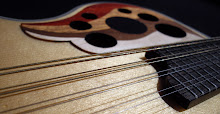Now we've all at some stage gone into a music shop to play around on their instruments to find that they haven't been tuned. It shouldn't happen but it does.
Even worse is when you get your brand new life partner home and find that you can't play it without tuning it. So where do you start if its the first time you have ever played an instrument? In this case, your brand new mandolin.
A couple of things you will need to know first is the layout of the land.
Being somewhat of a backward person myself, I'll start at the back. This is the Bridge of your mandolin. Well the back of MY mandolin, but you get the idea. When you restring your mandolin it will always start here.
This little baby is the Headstock. You will get to know this very well. Many frustrating hours of restringing, cursing at badly wound strings and surprised cries as you feel the sharp sting of a freshly cut string end as it slides ever so easily into your finger. Don't laugh. It really happens.
Let's get a little more intimate with your headstock. Pretty ain't it? These little beauties are called Machine Heads. They are often called tuning pegs but that is technically incorrect, but will suffice if that's how you will remember them. Try to remember machine heads though, you'll sound more like you know what you are talking about. That's half the battle. Machine heads, hold the strings nice and tight and you turn them to tighten or loosen the tension in each string, thus tuning them. If wound correctly, they will all turn the same way for tuning up and the same way for tuning down. I'll go into restringing and tuning later when I next break a string. The mandolin has 8 strings, thus has 8 machine heads.
Now we'll look at the business end, or middle end of the mandolin. The Neck and Fretboard. The fretboard is glued onto the neck and looks like this below.
A couple of things you will need to be aware of. The thick beige strip on the left is the Nut. The metal strips along the fretboard are called Frets. It's the vibrations of the strings between the nut and the bridge that create the sounds. Hold down a fret and you shorten the length of the vibrating string thus raising it's pitch. The frets are numbered from the left. so the one next to the nut is the first fret. When you hear me say 1st fret, you put your finger right behind the first fret., so between the nut and the 1st fret. Not actually on the fret itself as it will deaden the string (try it you'll see what I mean).
The dots or Inlays along the fretboard are there to not only look pretty but to help you find your way around. Located at the 3rd, 5th, 7th, 10th and a double at 12 frets. The 12th fret lays exactly halfway between the nut and the bridge.
As I said earlier. The mandolin has 8 strings. Get used to thinking of it as having 4 strings but 2 of each. I will often say things like the E string, meaning both E strings. Each of the set of 2 strings is tuned the same and it done this way to fill out the sound and give the mandolin it's unique flavour (or sound, but I already used sound in this sentence).
Now hopefully your mandolin salesperson was kind or greedy enough to on-sell a tuner to you. If not, go back and get one. It will make your life so much better. Starting at the top, your strings are tuned G, D, A, E. Remember... 2 of each. So, G, G, D, D, A, A, E, E.... So what I mean. When I say E, I really mean both E strings. Makes things less complicated, so start thinking of each set of 2 strings as 1. Now. If your mandolin is tuned correctly, if you play each of your strings open; i.e. without holding down any frets it will make those notes.
If by change you don't have yourself a tuner handy, I will show you how to at least tune your mandolin to itself so can play it. It will be in tune, maybe not in the right key, but it will at least be playable.
When tuned correctly. if you hold down (Fret) the G string on the 7th fret, it will make a D note. The same D note as playing the D string open. Same with the next strings as seen in the above diagram. 7th fret D string = Open A and 7th fret A string = Open E.
Hopefully that makes some sense. It's a handy way of tuning without having a tuner or when your tuner batteries are flat. Once again, this happens when you most need it. It's also a good way to make sure your mandolin is tuned correctly.
Also start trying to remember the notes on the fret board. The sooner you start remember things like that, the better you will be in the long one.
Well hopefully you all know your mandolin parts and how keep it in tune. If anything doesn't make sense, please feel free to message me and I'll try to fix it up.
Stay Musical
Mikey.
Friday, February 19, 2010
Subscribe to:
Post Comments (Atom)







Well, thanks, Mikey. I always wondered.
ReplyDeleteKeep it cummin, Mikey, aka Fantasy world, ugly kid Michael, rickets etc etc etc etc
ReplyDeleteGerry